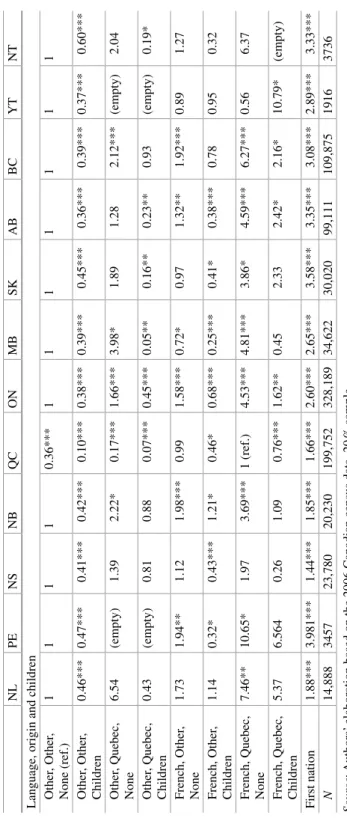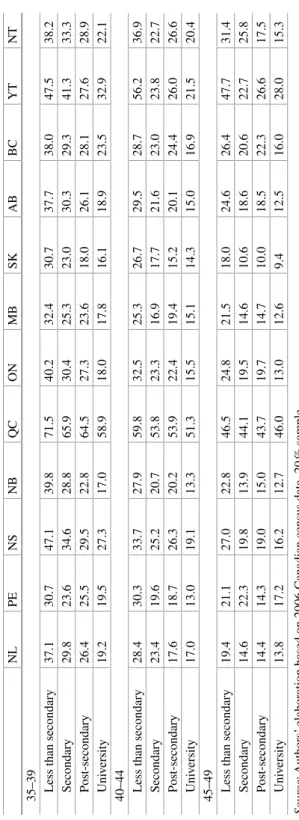It is widely believed that if the spread of a consensual union is primarily due to a change in the economic conditions of young people, then life in a consensual union should be negatively associated with education: the share of. In both cases, the proportion of women living in a consensual union should decrease with age. It is higher in Quebec and in the Territories than in the rest of Canada.
In 2006, the proportion decreases as education increases in the same way as among women aged 30–34.
The decline in the real median wage of men is probably a consequence of the delay in the transition to adulthood. If this is true, then economically independent women should be more likely to live in a consensual union than to be married in Quebec, but not in the rest of Canada. Furthermore, favoring values related to individual autonomy should increase the likelihood of living in a consensual union rather than being married in Quebec, but not in the rest of Canada, or, at least, not as much in the rest of Canada than in Quebec.
In the first we focus on the economic role of the woman in the couple. We use the fact that we are the main source of income in the family, combined with employment status, as an indicator of one aspect of women's degree of economic independence. We expect that women who are the main source of income in their families and who are in the labor force are more likely to live in a consensual union than to be married in Quebec, but not so much or less in the rest of Canada.
In the second analysis we focus on the effect of the level of individual economic security provided by work. We use the limited data available for Canada in the general sample of the World Values Survey to study the effect of the level of importance placed on individual autonomy on the probability of living in a consensual rather than married union. We expect that the probability of living in a consensual union increases with the importance placed on autonomy in Quebec, but not as much or less in the rest of Canada.
The Economic Role of the Woman in the Couple
The reference category for the measure of economic independence is the highest level, "Being the main support and being in the workforce". The reference category for the combination of speaking French, living in Quebec and having children was chosen to allow easy contextual interpretation: it refers to a majority group within each province. So it is speaking French, living in Quebec and not having children in Quebec, but not speaking French, not living in Quebec and not having children in all other provinces and territories.

The Level of Economic Security
Values
Due to the limited sample size, we cannot estimate separate equations for each province. However, we estimate the effect of the autonomy index and our proxy for the degree of economic independence separately for men and women.
The Economic Role of the Woman in the Couple
In Quebec, childless Quebec French-speaking women have the highest odds of living in a consensual union; for these women, having children reduces the chances of cohabitation by about 25. The odds are about the same for childless French-speaking women from elsewhere; For these women, having children reduces the odds by approx. 50. The odds of living in a consensual union for childless non-French-speaking women outside Quebec are about one-third of those for childless French-speaking women from Quebec; for these women, having children reduces the odds by about 75.
The odds for childless non-French-speaking women from Quebec are less than 20% of those for childless French-speaking women from Quebec; for these women, having children reduces the odds by about 60. French-speaking women from Quebec have the highest odds of living in a consensual union, and among them, having children reduces the odds by only 25. In Ontario , for non-French-speaking women from somewhere other than Quebec, having children reduces the likelihood of living in a consensual union by about 60.
Childless French-speaking women from Quebec have the highest odds, more than four times those of non-French-speaking women from other countries; for these women, childbearing reduces the odds by about 66%, much more than in Quebec. Childless non-French-speaking women from Quebec and childless French-speaking women from other countries have almost the same odds of living in a consensual union, roughly 60% higher than non-French-speaking women from elsewhere except Quebec; having children reduces the odds by about 75% in the first group and by about 60% in the second group. For French-speaking women from Quebec, childbearing has a stronger effect on reducing the likelihood of consensual union in Ontario than in Quebec.
The Level of Economic Security
Values
Having children reduces the odds in English Canada and in French Quebec, apparently more so in the latter than in the former. In French Quebec, the odds increase with the value of the autonomy index for men and women, perhaps more so for men than for women. There is still no relationship between the autonomy index and life in a consensual union for men.
In French Quebec, the odds increase with the value of the autonomy index for men and women, perhaps more so for men than for women, as in equation 2.
The probability of living in a consensual union is related to women's level of economic independence as expected in Quebec, but also in British Columbia. In these two provinces, women who are the main source of income are more likely to live in a consensual union. However, living in a consensual union is clearly related to the level of economic security among Quebec women, but not among men and not elsewhere in Canada.
Net of our measure of economic independence—that is, net of their actual situation in terms of income and participation—the importance placed on autonomy increases the likelihood of living in a consensual union among women from English Canada and among men and women in French Quebec. Individual characteristics and their effect do not explain much of the difference between the two sociolinguistic groups. Second, outside of Quebec, consensual union appears to be more common in eastern Canada than in western Canada.
An alternative interpretation of the effect associated with living in a CMA is to consider it as a proxy for immigration. The results we obtained would suggest that foreign-born people and children of immigrants are less likely to live in a consensual union than people born in Canada or born to Canadian-born parents. Alberta, and to a lesser extent Saskatchewan, received a significant influx of religious dissidents from German-speaking countries in the nineteenth century and today are home to the Canadian religious right.
Some provinces do not offer any abortion services, while Quebec is among the few provinces that offer them through a network of public and non-profit clinics; about 22% of pregnancies end in abortion in Quebec, but only 16.5% in the rest of Canada (Statistics Canada 2014; CIHI 2013. The main difference in the prevalence of cohabitation in Canada is between French Quebec and English Canada, but there are other differences We found two that, to our knowledge, have not been observed before: outside of Quebec, unmarried cohabitation appears to be more common in Eastern Canada than in Western Canada; unmarried cohabitation may be more common outside largest census metropolitan area than anywhere else.
Foreign-born Canadians might choose to marry rather than common-law for a variety of reasons, including, regardless of cultural or religious issues, the easier it is to ensure the transmission of their original citizenship to their spouse and descendants. In addition, the low proportion of cohabiting people in Alberta and Saskatchewan is likely related to a combination of religious conservatism and an oil-based economy. Overall, research on cohabitation in Canada suggests that exploring differences in the meaning of marriage could help understand differences in the prevalence and circumstances of cohabitation.
In Quebec, competing views lead to a wide divergence in some of the civil effects of marriage and consent, and to choices that lead to different outcomes in the event of a breakdown. Open Access This chapter is distributed under the terms of the Creative Commons Attribution-NonCommercial 4.0 International License (http://creativecommons.org/licenses/by-nc/4.0/), which permits any non-commercial use, duplication, adaptation, distribution and reproduction in any medium or format, as long as you give appropriate credit to the original author(s) and source, provide a link to the Creative Commons license, and indicate whether changes have been made. The images or other third-party material in this chapter are included in the work's Creative Commons license, unless otherwise noted in the credit line; if such material is not included in the work's Creative Commons license and the action in question is not permitted by statutory regulation, users must obtain permission from the licensee to duplicate, adapt or reproduce the material.
The Marriage, Union, and Community of Québec and Ontario. The recent evolution of marital fertility and consensual union in two Canadian provinces: untangling the fertility paradox in Quebec. The Evolution of Beliefs and Opinions on Matters Related to Marriage and Sexual Behavior of French-Speaking Catholic Quebecers and English-Speaking Protestant Ontarions.
In Session 212: Cohabitation and Marriage , 2014 Annual Meeting of the Population Association of America (PAA), Boston, USA, 1–3 May.

